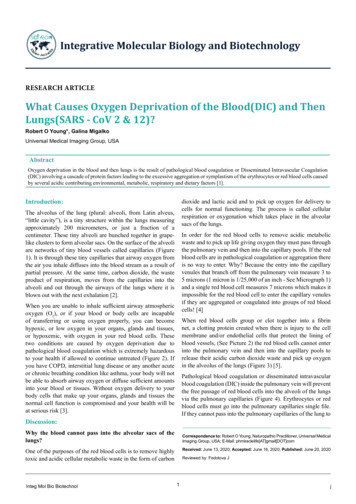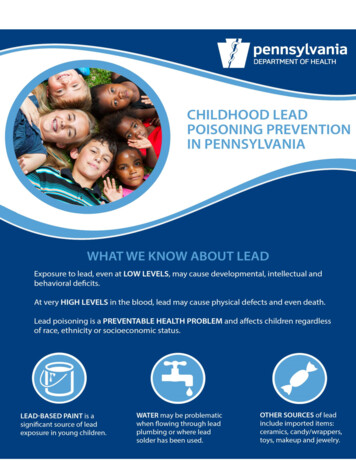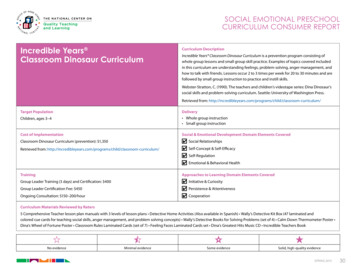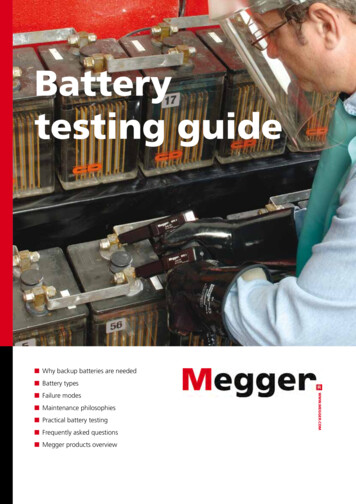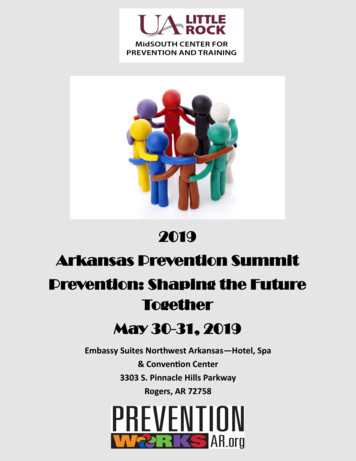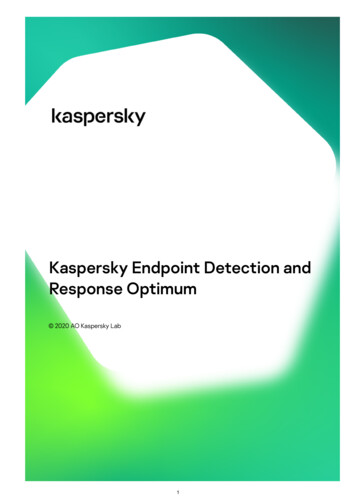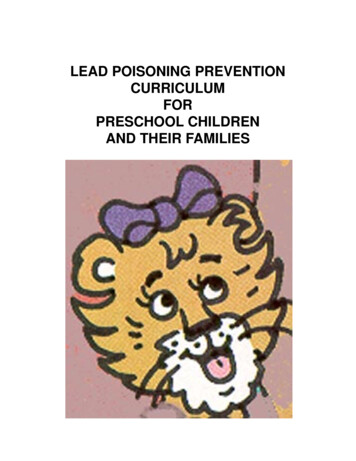
Transcription
LEAD POISONING PREVENTIONCURRICULUMFORPRESCHOOL CHILDRENAND THEIR FAMILIES
I
Production of the Lead Poisoning Prevention Curriculum for Preschool Children and TheirFamilies was funded by the Erie County Department of Health through a New York StateDepartment of Health-Public Health Campaign grant. The information and views presentedin the Lead Poisoning Prevention Curriculum for Preschool Children and Their Familiesrepresent those of the authors and do not necessarily represent those of the Erie CountyDepartment of Health.Contact the NYS Department of Health for additional copies of this document.Telephone: 518-402-7530 or (800) 458-1158E-mail ceheduc@health.ny.govFax (518) 402-7539Mail: NYSDOH Outreach and Education GroupESP, Corning Tower Rm. 1642Albany, New York 12237Note: The original Erie County curriculum for 4 and 5-year olds was revised by the NewYork State Department of Health in 1998 prior to distributing it to Head Start programsserving 3 and 4-year olds. This document reflects the State DOH changes.II
Curriculum CreditsAppreciation and thanks are given to the conscientious and enthusiastic members of the LeadPoisoning Prevention Curriculum Committee.Committee Members:-Judith Bunn, MS., RD., WNY Nutrition Education and Training (NET) Program, Mt. Morris, NY.-Theresa Calvin, BSN., Health/Mental Health Coordinator, Community Action Organization of Erie County, Inc.,Buffalo, NY.-Brian English, Erie County Department of Health, Public Health Campaign, Buffalo, NY.-Barbara Frase, LN., Nurse Manager, Coordinator of Lead Program, Ambulatory Pediatrics, Children’s Hospital ofBuffalo, Buffalo, NY.-Nancy Heidinger, PHN., RN., Erie County Department of Health, Childhood Lead Poisoning PreventionProgram, Buffalo, NY.-Barbara Goldpenny, American Dairy Association and Dairy Council, Western New York.-Suzanne Grossman, RD., Women, Infant and Children Program, Buffalo, NY.-Kathleen Lesniak, Parent and President, Western New York PTA, Buffalo, NY.-Donald Levin, MA., Associate Executive Director, Prevention Resource Center, Buffalo State College, Co-Chair,Buffalo, NY.-Barbara Longacre, Lead Poisoning Prevention Specialist, Developmental Disabilities Prevention Program/People, Inc., Co-Chair, Williamsville, NY.-Cecile Mathis, JD., RD., Food Bank of Western New York, Buffalo, NY.-Carol B. Melson, Assistant Education Coordinator, Community Action Organization of Erie County, Inc., HeadStart Program, Buffalo, NY.-Diane Moats, LN., Health and Safety Officer, Nurses United, CWA Local 1168, and Health and Safety Officer,Buffalo General Hospital, Buffalo, NY.-Valerie Niezgoda, RD., Geneva L Scruggs Community Health Center, Buffalo, NY.-Ellen O’Callaghan Sheldon, Education/Career Development Training Coordinator, Community ActionOrganization of Erie County, Inc., Head Start Program, Buffalo, NY.-Elsa Peters, RD., Nutrition Resource Person, Grand Island, NY.-Sharon Thayer, RD., Women, Infant and Children Program, Buffalo, NY.-Joe Zielinski, MPH., RD., Monroe County Department of Health, Public Health Educator, Rochester, NY.The Curriculum Committee wishes to thank the following individuals for their significant contribution to thedevelopment of this curriculum.Project Consultant:-Olivia Smith-Blackwell, MD., Regional Health Director, New York State Department of Health, Buffalo, NY.Associate Project Consultants:-Frank Beyer, State Education Department, Safety Education, Albany, NY.-Lillian Brand, Early Childhood Educator, Hamburg, NY.-Melinda Cameron, MD., Medical Director, Childhood Lead Treatment Program, Director of Pediatrics, ErieCounty Medical Center, Buffalo, NY.-Marguerite Korzelius, Director of New York State-Funded Pre-K Program, Buffalo, NY.-Janice Kostek, Director, A Children’s Place of Buffalo, Buffalo, NY.-Cara Metcalf, Early Childhood Program Specialist, Buffalo Speech/Hearing Center, Buffalo, NY.-Byrna Nye, Education Supervisor, Bethel Head Start Program, Buffalo, NY.-Diane Panepento, Director, Erie County Board of Cooperative Educational Services Preschool Program,Depew, NY.-Jeanne Peterson, Director, Small Wonders Preschool, Amherst NY.-K. Aurelia Raciti, MD., Consultant, Westchester County Department of Health, Hawthorne, NY.-Leila Samuels, Retired Early Childhood Specialist, Amherst, NY.III
AN ADDED NOTE FROM THE STATE HEALTH DEPARTMENT:This curriculum can be enhanced by using a “kick-off” program prior to using the songs,recipes and activities. One such program was piloted in the Capital District that started with ashort Sesame Street lead awareness video and was followed by a 5 to 7 minute skitfeaturing Lena the Lead-Smart Lion. We have two other suggestions for programs you maywant to consider - one is to do a briefer version of the Lena skit for the children themselvesto act out. This has the advantage of involving them directly and bringing their parents in towatch them perform. It may make a better end-of-year activity rather than a kick-off. Youmay also want to consider asking local high school students to play the roles in the Lena skitor one you create yourselves. We think some sort of program with the children and/or theparents is an excellent way to introduce or reinforce the key messages in this curriculum.Visual materials are available for your use. Copies of the Sesame Street video are atregional Head Start offices. The script for the skit, costume patterns and a model for a handpuppet for the children to use are included as Appendix 1. The State Health Department hasstickers and coloring books for the children, as well as educational materials for parentsabout reducing exposure to lead.We encourage you to make this curriculum work for you. You may want to follow the fiveunits as they are written. In our pilot effort we learned that some Head Start programs preferto select different pieces that fit in with whatever theme they happen to be working on. It isimportant to involve parents and care givers. Sending letters home with children may work,as may handing out packets on parent program nights, conducting home visits, mailing lettersto the home, or putting on the skit with children as mentioned earlier.We’re interested in hearing more about how you use this curriculum and what you think thechildren and their parents/care givers may be getting out of it. We would appreciate yourusing the evaluation forms for kids, teachers and parents that are included in Appendix 2.We also revised the curriculum to include a list of resources for more information about lead.Teachers who were using the curriculum activities throughout the year requested a simplified,consolidated letter to parents to use instead of the letters for each of the five units. Theconsolidated letter and resource list are included as Appendix 3. Both the resource list andthe letter reflect the student-directed learning techniques employed by Head Start moreaccurately than the teacher-directed model envisioned for the 3-4 year old curriculum.IV
V
Lead Poisoning Prevention Curriculum for Preschool ChildrenTABLE OF CONTENTSTeacher’s Letter.Teacher’s Guide.Stories.Songs.Craft Section.Parent Letter of Introduction.Unit 1: Lead Sources.Unit 1 Parent Letter.Unit 2: Lead is a Poison, Behaviors for Preventing Lead Poisoning.Unit 2 Parent Letter.Unit 3: Foods High in Iron.Iron-Rich Snacks and Recipes.Unit 3 Parent Letter.Unit 4: Foods High in Calcium.Calcium-Rich Snacks and Recipes.Unit 4 Parent Letter.Unit 5: Preventing Lead Poisoning.Unit 5 Parent Letter.Appendix 1: Program Kick-off for Head Start.Appendix 2: Evaluation Forms.Page 1Page 2Page 6Page 12Page 14Page 16Page 18Page 22Page 24Page 30Page 32Page 36Page 40Page 42Page 45Page 48Page 50Page 52Page 54Page 66Appendix 3: Resource List and Head Start Parent Letter.Page 72NOTE:Each unit contains facts and background information which are important to thepresentation and success of this lead curriculum.VI
Dear Teacher:The lead poisoning prevention curriculum is designed for use with 4 & 5 year old Pre-K students.Lead poisoning is the nation’s number one preventable, environmental health problem facingour children today. The curriculum brings children, parents/care givers, and teachers together tohelp prevent this problem.Developed and tested by experts in child development, public health education, nutrition andhealth care, the curriculum contains five complete, flexible units. They can be tailored and adaptedto meet the needs of your students.In this packet you will find: A Teacher’s Guide with an overview of the lead poisoning problem and suggestions forusing the curriculum.Five units complete with learning objectives, teacher background information, guidelinesfor program implementation, activities, follow-up discussion questions, songs and ideasfor optional arts and crafts projects.A full complement of informational materials for parents or care givers.The curriculum materials, stories, songs and recipes.We hope you will find these activities both instructive and enjoyable. They will assist you inteaching your children to become “helpers” in preventing lead poisoning.If you have any questions or comments about the curriculum materials, please share them withus. On behalf of the Preschool Lead Poisoning Prevention Curriculum Committee, weappreciate your willingness to help PREVENT LEAD POISONING.Sincerely,Lead Poisoning Prevention Curriculum CommitteeQuestions or comments to:c/o Developmental Disabilities Prevention Program/People, Inc.1219 North Forest Road, P.O. Box 9033, Williamsville, NY 14231-9033(716) 634-81321
Teacher’s GuideLead Poisoning Prevention CurriculumforPreschool ChildrenTarget Population:Four and five year old Pre-K students and their families.General Educational Objectives:To make children aware of the dangers of lead in their environment and to have childrendemonstrate behaviors that will help prevent them from becoming lead poisoned. The ultimategoal of the curriculum is to alert parents/care givers to the dangers of lead poisoning in theirhome in order that they may implement the precautions needed to protect their children frombecoming lead poisoned.Specific Learning Objectives:Each child will be able to:1. Identify three primary sources of lead in the environment. These are: paint, dust andsoil.2. Identify lead as a poison found in the environment and demonstrate a minimum of twobehaviors which will help prevent lead poisoning.3. Identify one or two foods that are rich in iron which will help prevent children’s bodiesfrom absorbing environmental lead.4. Identify one or two foods that are rich in calcium which will help prevent children’sbodies from absorbing environmental lead.5. Identify the main points of objectives 1 through 4 above. Name at least two (2) waysthat he/she can be a lead poisoning prevention helper.Why This Curriculum is ImportantTeacher Facts and Background Information:Fact:Lead poisoning has been referred to as the “silent epidemic.” Rarely are there visiblesymptoms. A child may not look or act sick. Lead poisoning is our nation’s number onechildhood environmental health problem. When lead accumulates within a child’s body itaffects that child’s normal growth and impacts upon his health, behavior and intellectualdevelopment.2
Background:The Centers for Disease Control (CDC) in Atlanta GA, consider children between nine monthsand six years old, exposed to houses built before 1978, to be at greatest risk. This is the agewhen the brain undergoes its greatest development and body weight is at its lowest. The CDCestimates that 3 to 4 million children between the ages of nine months and six years of age areat risk for lead poisoning.The effects of lead poisoning depend on how much lead has been absorbed into the body andthe duration of the exposure to lead. Symptoms are often hard to detect and may lie dormantfor many years. A child poisoned at two years might be more likely to drop out of high schoolor have a lower IQ than his contemporaries.Fact:The only sure way to determine whether a child has a high blood lead level is to have that childtested annually for lead poisoning. This is particularly true for those children living in olderhomes where the risk of lead poisoning is greater. Consult with your physician.Background:In the majority of lead poisoning cases there may be no warning signs or signs may be ascommon as fatigue, loss of appetite, irritability, sleeping problems, or sudden behavioralchanges. More serious indications include pica (the eating of non-edible items), clumsiness orloss of muscle control, weakness, abdominal pain, vomiting, constipation and changes inconsciousness. In severe cases, coma and death can occur.HOW TO USE THE LEAD POISONING PREVENTION MATERIALSGeneral Information:Each of the five units, like the Teacher’s Guide, is introduced with lead poisoning facts andbackground information. This helps the teacher understand why children need to learn leadpoisoning prevention behaviors. Throughout the curriculum, children are introduced to thedangers of lead poisoning and how it can be prevented. The units are self-contained. Eachunit contains specific learning objectives. The curriculum is flexible enough to be used within aweek, a month or over the course of a term. The teacher can then reinforce lead poisoningprevention habits throughout the year.The curriculum has been designed to involve parents/care givers as an integral part of thechild’s learning experience. Adult involvement is essential to the success of the curriculum.Parents/care givers need to be aware of the effects of lead poisoning and steps they can taketo reduce their child’s risk of becoming lead poisoned. At the end of each unit a letter will besent home to parents/care givers suggesting activities which can be done together.3
After completing the curriculum each child can be awarded a certificate indicating that he/sheis a helper in preventing lead poisoning. The certificate can be as creative as the teacherwishes.Before Introducing the Curriculum:The first step in using the Lead Poisoning Prevention Curriculum is to read through theTeacher’s Guide to familiarize yourself with the program. Points felt important for teachers tostress are noted in the learning objectives. Teachers are encouraged to use their imaginationand to use the ideas provided, improvising and tailoring them to their needs.NOTE: The day prior to using this curriculum, send home the suggested introductory letter toparents found at the end of this section of the Teacher’s Guide.Methods:Concepts about lead poisoning prevention will be taught in the following ways: An introductory letter to parents/care givers informing them of the lead poisoningprevention curriculum.Take home letters to parents/care givers accompany each unit to encourage homeparticipation.Take home information to share with parents/care givers such as recipes, etc.Hands on classroom activities.Stories about lead poisoning prevention.Classroom discussion.Songs and arts and crafts projects.Certificate of completion indicating that a child is a Lead Poisoning Prevention Helper.(Certificate created by the teacher.)For interested parents and care givers, teachers are encouraged to arrange for asupplemental session on lead poisoning prevention by calling their local County LeadPoisoning Prevention Program for a speaker. Please refer to the Resources Sectionfound in Appendix 4 for a list of County Lead Prevention Programs and their phonenumbers.Curriculum Components:StoriesStories are provided for teachers to use with the children. Little. (you add name of insect) Goes ExploringThe Bug Family Learns About Lead4
SongsSongs to reinforce concepts and ideas concerning lead can be found within this section of theTeacher’s Guide. Sending songs home for parents/ care givers allows them to sing along withtheir children.ActivitiesIdeas for implementing craft activities are in the Crafts Section of the Teacher’s Guide.Dramatic ActivitiesRole playing provides children with opportunities to be creative while dramatizing behaviorsand good habits to prevent lead poisoning.Children enjoy being helpers. Dramatic activity provides a way to express their helpfulnatures. Role playing situations suggested by the teacher can serve to reinforce ideas andconcepts from the lessons.Lead Poisoning Prevention Helper for a DayDesignate a child to be a lead poisoning prevention helper for the day. The child will helpremind others to wash their hands, not put objects in their mouths, etc.StorytellingUsing the children’s ideas and words, the teacher creates a story that can be printed up andsent home.Food ActivityMake a doll or puppet with an open mouth. Use a see-through net or long sock for the doll’sbody. Ask children what things are good to put into their mouth. Those things that are goodcan be placed in the doll’s mouth. Those things that are not good can be placed in a trash can.Inappropriate items include: paint chips, toys, railings, window ledges (use pictures), etc. Itemsto be eaten include all of the foods recommended in Units 3 and 4.Brochures can be acquired through your local Department of Health.5
LEAD POISONING PREVENTION STORIESLITTLE (add insect name of your choice) GOES EXPLORINGby Don LevinThis is a story that happened once upon a time . . .Little (add insect name here) lived with his Mother in a room in a very big, very old house.Each day, Little asked his mother, “May I walk through the rest of our house? Iwould like to meet our neighbors and play in their rooms.”Mother would say, “This is a very big, very old house, and you must wait until you are biggerand older before you may explore it.”Little sighed, and said, “I understand.”Walking about he explored all the nooks and crannies of the windows in his room.And he explored the baseboards. And the cabinets. And the floor.Each day his Mother reminded Little not to eat the paint chips that sometimes fell onthe floor. And to wash the dust from his hands with soap and water. And to keep his hands outof his mouth.“There may be lead in the dust around the windows,” his mother told him. “And in the paintchips from the baseboards, and on the cabinets, and on the floor in our room. Lead is verybad for you. It will make you sick, and make it hard for you to learn new things. So you mustalways remember to wash the dust off your hands after exploring, and never put paint chips inyour mouth.”Little did what his mother asked him to do.One day, Mother was busy making a polka dot quilt when all of a sudden a gust of wind blew inthrough the open window - and blew the door open the tiniest bit.Little peeked out into the longest hallway he had ever seen. Quick as a winkanother gust of wind came in through the window and blew Little right out intothe hallway. And blew the door closed behind him!At first, Little was afraid to be out in the hallway all by himself. Then, he realizedhe finally had the chance to explore his old house.He walked down the hallway until he came to an open doorway. He went into the room.6
Inside he found ten fat cats sitting around giving each other baths with their tongues, as catslike to do.“Hello,” said one of the cats. “Welcome to our room. Please explore it, if you would like to.”“Thank you,” said Little .He went up to the window, where he explored the nooks and crannies of the window sill andthe well where the window slid up and down.“Did your mother tell you that you should wash the lead dust from your hands with soap andwater after you explore?” a fat cat asked Little .“Oh yes,” said Little . “I must wash the lead dust off so I don’t get sick.” And hewashed his hands, and said good-bye to his new friends, and went out into the hallway again.There he found another open doorway. Inside another room, he found twenty scamperinghamsters.One of the scampering hamsters said, “Hello, Little . Welcome to our room.Would you like to explore?”“Oh yes, very much!” said Little .And he went to the baseboard, where he explored every nook and cranny.He found a big piece of paint chip that had fallen off the baseboard. He brought it into thegroup of scampering hamsters. “Look what I found,” he said. “I bet this is good to eat.”“No!” said a hamster. “Didn’t your mother tell you that you must never eat paint chips? Theywill make you very sick.”Little put the paint chip in the waste basket, and washed his hands. Then he saidgood-bye to his new friends, and went out into the hallway and into the next open doorway.There Little found another room with forty silly billy goats, standing around andchewing.One of the silly billy goats said, “Hello, Little . Please explore our room.”He went around the floor, where he explored every nook and cranny.He remembered all by himself not to put the paint chips from the floor into his mouth.He remembered all by himself to wash his hands as his mother had taught him.“Won’t you join us, Little ?” one of the silly billies asked. “We’re chewing on some7
paint chips we found on the floor and chewing on the paint on the window sill and licking thedust off our hooves.”Little said, “You shouldn’t eat paint chips, and you shouldn’t put dust near yourmouth. You may get lead poisoning. It will make you sick, and make it hard for you to learnnew things.”But the forty silly billies ignored him, and chewed their paint chips, and gnawed on the windowsill.Just then Little heard his mother. “Little ! Where are you?”Little went out into the hallway.“Little ,” his mother cried. “There you are! What happened?”Little told her about the wind that blew him into the hall. And he told her about the tenfat cats, and the twenty scampering hamsters, and the forty silly billies chewing on paint.“That is very dangerous,” said his Mother. “Lead in the paint chips and in the dust can makethem very sick. I will let their mothers know about what they are doing, so they can learn howto protect themselves from lead poisoning”.“And do you know what else? I remembered to wash my hands with soap and water afterexploring, and to keep my dirty fingers out of my mouth,” said Little proudly.Mother smiled at her child. She knew Little was finally big enough to go exploringon his own after all.And after that day, he did.And he never ate paint chips, and he never put dust in his mouth. And when he played outsidewhen the springtime came, he always washed the dust and dirt off his hands because he knewthe soil contained lead dust from the paint chips which had fallen off the house into the soil.And he learned to help his mother keep the house clean and lead free.And Little and his mother were happy and healthy, ever after.The End8
THE BUG FAMILY LEARNS ABOUT LEADby Brian EnglishOnce upon a time, a family of bugs lived in a garden. There was Momma Bug, Poppa Bug andtheir daughter, Latasha. After a rain filled night, the bugs awoke to bright sunshine.“Good morning! How did everyone sleep last night?” asked Poppa Bug.“Great. I was tired from working in the garden yesterday,” answered Momma Bug.Latasha, their daughter replied, “The rain kept me up, raindrops kept dripping on my leaf.” Shedid look tired.From the kitchen Momma called, “Breakfast is ready.”Latasha ran into the kitchen and sat at the table.With a frown on his face that Latasha didn’t notice, Poppa asked, “Latasha, have you forgottensomething?”“Yes, I left my doll in my room,” answered Latasha. “I planned to take her with me this morningto Tina’s house.”“That’s not what I meant,” said Poppa Bug.Latasha looked puzzled. “Well, Dad, what DID you mean?” she said.“You sat down at the table and forgot to do something very important before eating yourbreakfast,” Poppa reminded her. “Would you please go wash your hands?”Latasha ran to the sink. She grabbed the soap and began to scrub her hands. Momma andPoppa Bug joined her.“Dad, why is it we ALWAYS have to wash our hands before eating?” asked Latasha as shewas drying her hands.“Even though you can’t see the dirt on your hands, it is there. By keeping your hands cleanyou are protected from having dirt get on the food which you eat. You see, dirt has LEAD in it.When lead gets into your body it CAN MAKE YOU SICK,” warned Poppa Bug.As Latasha sat down to breakfast she could smell the toast, eggs and oatmeal Momma Bughad made. Momma Bug made sure her family ate good, healthy food. She knew it wasimportant to prepare foods high in calcium and iron to keep them healthy and strong.After finishing her breakfast, Latasha kissed her parents goodbye and left for Tina’s house.9
Poppa and Momma Bug got a pail of soapy water to mop the leaves of their garden home.They used a damp dust rag to dust the furniture to help protect their family from leadpoisoning. They often told Latasha about how lead found in the dust, dirt and soil could makethem sick. As they worked, they hummed the song Lead Can Hurt Us.Latasha knocked on Tina’s door. Tina welcomed her and suggested they take Tina’s baby sisterwith them up to her room to play house. “We can watch the baby while we play,” she said. “Youknow what? I got a new kitchen set for my birthday,” Tina told Latasha.“Goody, let’s play with it. Shall we pretend to make cookies?” asked Latasha.They took out the play dishes and toy stove. Tina found flour in her play cabinet and began tomix the dough. Some flour got on Latasha’s wings, making them all white. The baby startedlaughing and knocked her pacifier on the floor. Tina quickly picked it up and was about to put itback in her sister’s mouth when Latasha cried, “Stop, don’t do that.”“Why not?” asked Tina. Latasha explained how in school they had learned about a poisoncalled LEAD which could make them sick.“My teacher said it was important to keep our hands away from our mouths. She told us that ifbaby things like pacifiers and toys fell to the floor they should be washed. She told us how tobecome lead poisoning prevention helpers.” Latasha washed the pacifier and gave it to thebaby.“Hey, thanks, Latasha, for watching out for my sister,” said Tina. “I thought the only way to getpoisoned from lead is to eat paint chips.”“Yes,” said Latasha. “You are right. NEVER EAT PAINT CHIPS. But eating paint chips is notthe ONLY WAY we can become lead poisoned. We need to remember to wash our handsbefore we eat, to eat healthy foods and to keep our hands and toys out of our mouths. If wesee a baby or our friends doing these things we must tell an adult. Either our parent or ourcare giver.”“You are a smart bug,” Tina told Latasha. “You have helped me to learn and you have helpedmy sister, too. Thanks for washing off her pacifier. Thanks for helping her not to become leadpoisoned. I am going to tell my mother about the things you taught me.”“Well,” said Latasha proudly. “My teacher taught me to be a LEAD POISONING PREVENTIONHELPER. I like being a lead poisoning prevention helper.”“How do you know if you have lead in your body?” asked Tina.“When I was little, my mom took me to the clinic to have my blood tested,” replied Latasha.“I’m going to ask my mom if I ever had my blood tested like you,” said Tina. “Let’s finishmaking our cookies.”After they finished playing, Latasha went home for lunch.10
“Hi, Latasha, did you have fun at Tina’s?” Momma Bug asked. Latasha told her mother aboutplaying at Tina’s and about washing the pacifier.“Well that was a very good thing to do. You’re learning to be a Lead Poisoning PreventionHelper,” said Momma Bug.“I’m hungry, what’s for lunch?” asked Latasha.“We are having peanut butter and jelly, along with a fruit cup. But what is it we need to dobefore we eat?”“I remember, I must wash my hands,” said Latasha.“That’s right. You’re such a good helper. Now hurry so we can eat,” said Poppa Bug who hadjust returned from the hardware store.The Ladybug family had their lunch, and then happily took their naps knowing that they weredoing the right things to help keep their home lead safe.The EndACTIVITY1. Teach the children the song Lead Can Hurt Us found in the Teacher’s Guide.2. Read the story.3. DISCUSSION QUESTIONS What are some of the things NOT
The lead poisoning prevention curriculum is designed for use with 4 & 5 year old Pre-K students. Lead poisoning is the nation’s number one preventable, environmental health problem facing our children today. The curriculum brings children, parents/care gi



